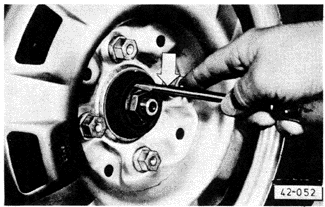Adjusting Rear Wheel Bearings
The rear wheel tapered roller bearings must be adjusted to work smoothly and minimize wear. This adjustment must be made any time the rear brake drum or rotor has been removed. Other periodic bearing adjustments to compensate for wear may help to increase bearing life or give early warning of excessive wear and the need for replacement. The only materials needed are a little extra multipurpose grease for the grease cap, and new cotter pins.
To adjust:
| 1. | Raise the rear of the car, support it securely on jack stands which are designed for the purpose, and remove the wheel. |
| 2. | Carefully pry off the grease cap in the center of the brake drum or disc, remove the cotter pin and nut lock, and then loosen the axle nut. |
| 3. | If the wheel bearings, especially new ones, have just been installed, temporarily torque the axle nut to 10 Nm (87 in. lb.), while turning the brake drum or rotor by hand. Then loosen the nut slightly. |
CAUTION-
Avoid overtorquing the axle nut, as this may damage the bearings and bearing races.
|
| 4. | Tighten the axle nut again, slowly and in small increments while turning the wheel, until the thrust washer can just barely be moved back and forth with a light push on the tip of a screwdriver, as shown in Fig. 6-6. |
NOTE-
Do not twist or pry with the screwdriver. Use hand pressure only.
|
| Fig. 6-6. | Wheel bearing adjustment being checked Axle nut is tightened correctly when thrust washer moves only with slight pressure. |

|
| 5. | After the wheel bearings are correctly adjusted, install the nut lock so that its projections do not cover the cotter pin hole. If necessary, tighten the axle nut slightly so that the nut lock will align with the hole in the stub axle. Then install a new cotter pin. |
|
